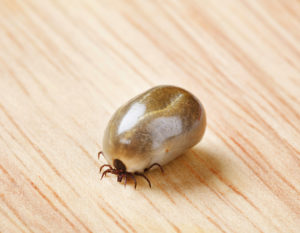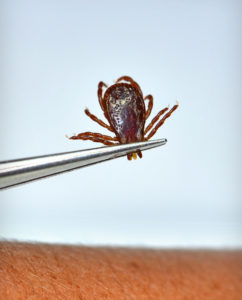Tick-Bite Tale from the ER: “Doctor, There’s a Seed Attached to Me!”
Does a tick bite call for emergency medical treatment? Our contributing physician says no, don't panic—but do watch closely for symptoms of Lyme and other tick-borne diseases.
A distraught man arrived in the Emergency Department: He was clearly upset and worried and had all the signs of mild panic—that being rapid breathing, fast heartbeat, and an anxious demeanor. He was fully ambulatory, and in our triage area, it appeared he had stable vital signs, no fever, and no actual respiratory distress. But he was scared. Apparently, he had showered and found a small, hard lump—or “seed,” as he referred to it—in his left axilla (armpit). The culprit? A tick—with the prospect of tick bite complications creating the patient’s anxiety.
In the warm spring and summer months and other times of year that are unusually warm, we field an abundance of Emergency Room complaints pertaining to various “bug bites.” People come into the ER often sporting a welt, rash, bump, or bite. These are minor complaints, on the scale of ER visits, and pose no real danger in the short term. However, some of these complaints need to be separated from the pack as issues that may require real attention and treatment.
Tick Bite Issues
Bites of any kind are a broad and varied topic that cannot be covered in one article or lecture, so for this post, I will focus on bites from arthropods, or “bugs,” as the lay community calls them—specifically, tick bites.
The unseasonably mild 2016-17 winter in the Northeast unleashed an abundance of adult ticks who lived through the winter. The result in my area of practice (the New York metro and suburban areas, Westchester, and southern Connecticut): an increased frequency in reported tick bites and associated illnesses, such as Lyme disease, Ehrlichiosis, and Babesiosis.
In fact, these infectious entities are found in many temperate and subtropical areas of the U.S., but the prevalence is highest in the Northeast and upper Midwest. In recent years, more and more ticks carrying Borrelia are found west of the Mississippi. Rocky Mountain Spotted Fever (RMSF) is actually most common in the southeast United States, although initially named for the Rocky Mountains, where it was first described. For the purposes of this discussion, I will concentrate on tick bites themselves and not on the various illnesses that may result.
Digging in on Tick Bite Information

Pictured: A sight that will disgust most of us: an engorged tick, after having fed on its unwary host.
© Ajafoto | Dreamstime
Patients have been signing in to the Emergency Department (ED) this past summer in greater numbers than usual because of the increase in tick populations in my area. A common story is that the patient is in the shower or bathroom when they see a “seed,” or dark spot, hanging off their skin. Often, it’s a spouse or significant other who finds this parasitic hitchhiker.
These patients are often anxious and upset and want some reassurance. Because they have so many questions and concerns, they seek answers at the Emergency Room or in Urgent Care facilities. Clinicians in my area have a depth of experience with such encounters, and have developed a comfortable understanding of initial approach and treatment of tick bites and related illness.
I write this article as a simple discussion of basic facts, gearing it toward the lay population so as to allay anxieties and fears that often accompany tick bites. If you have a concern about a tick bite, I hope this practical information will provide some reassurance, help guide your decision-making, and perhaps allow you to avoid unnecessary testing and treatment.
Is a Tick Bite Dangerous?
Ticks in our area are of the Xiodes Scapularis species (called deer ticks) as well as species of the dog tick variety. They are typically active in warmer months—between March and November—but also at other times in mild weather. Their primary host is the white-tailed deer. Other hosts include mice, birds, rodents, and domestic animals (our own cats and dogs). Any of these creatures can carry ticks close to us, so they fall in our proximity. As such, we can become accidental hosts—and subject to illness.
A tick may then attach itself to us in process of feeding on our blood for its own nourishment. By so doing, the tick completes a life cycle—from nymph stage to juvenile to adult. When a tick feeds, it siphons blood into its digestive system by sucking through a puncture in skin as it holds on via a barbed proboscis and mouth parts (it’s sort of like a straw that hooks on).
The tick feeds for several days and will then drop off, mature to its next stage, eventually mate with other ticks, and complete the cycle when it has offspring.
Is It Necessary to See a Doctor When You Discover a Tick Bite?
There are some common questions and principles that cause concern when people spot a tick or tick bite; I hope I can clarify.

Ideal way to remove a tick: Use tweezers, and pull from as close to the tip of its mouth as possible. See “How to Remove a Tick” sidebar. [Photo: © MorganOliver | Dreamstime]
The first is: “Do I have to go to the ER if I find a tick on me?” The very simple answer is “No!” If you or a friend is comfortable removing a tick with simple forceps, tweezers, or even a credit card, then it’s not necessary to wait hours in an ER. Removing a tick is simple mechanics, and can be done by a non-medical person. (See “How to Remove a Tick” sidebar, below.)
Secondly: “Do I need antibiotics because I was bitten by a tick?” The answer, again, is “No!” Most tick bites will not result in any long-term or acute infection if they are removed within 24 hours.
A given deer tick in the Northeast has approximately a 10 percent chance of carrying the Lyme disease causative agent, Borrelia. In a given tick that has been attached to an individual for one day or less (and that carries Borrelia bacteria), there is a roughly 10 percent chance of Lyme disease transmission. The rough statistics, then, for a given tick bite is 1 in 100 bites results in Lyme disease transmission. For most discovered tick bites that are removed when they are found, there is a very small chance of contracting Lyme disease.
So why, then, is the prevalence of Lyme disease relatively high in Lyme prone regions? The answer is that most cases of Lyme disease are the result of a tick bite that is never discovered. Most people who come down with Lyme disease symptoms are never aware of the attached tick.
Any close look at a deer tick in any stage (nymph, juvenile, or adult) will demonstrate how easy it would be to hide a tick in a body crevasse, hairline, or hard-to-see area. In these cases, the first symptoms often are fever, body aches, headache, and malaise.
In some individuals, the classic “target rash” (Erythema Chronica Migrans) will be visible. This bull’s-eye rash makes the diagnosis easy, and starting medication an easy decision. We are probably fed on by many more ticks—ticks we’re never aware of—than we can imagine.
Tick Bite? Don’t Panic
All of this brings us back to the concept that if we find a tick attached to us, there is no reason to panic. Simply removing it is sufficient. But it does bring up another question: Should we start prophylactic antibiotics? The answer is No!
Recent studies have suggested that taking several doses of antibiotics after a tick bite may lessen the risk of contracting Lyme disease.
Several years ago I was giving one or two doses of doxycycline for a discovered tick bite as a possible prophylaxis. The most recent data, however, suggests that there is no protective benefit in taking several doses of antibiotic for a given bite.
Now the standard of care is to treat Lyme disease with a full course of antibiotics, but to hold off on antibiotics for a tick bite.
In the past, the standard course of Lyme disease treatment was 14 days, but most forward-looking physicians now realize that a minimum of three weeks of treatment is more effective.
Recent data also suggests that 30 or more days of treatment may be most effective for maximum eradication of Borrelia infection, or Lyme disease, and that even a double dose of doxycycline may be necessary to further reduce disease re-occurrence and chronic illness.
Tick-Bite Symptoms?
The final take-home point in this discussion is that tick bites themselves are nothing to panic over and most individuals should be able to treat themselves without visiting an ER or Urgent Care facility.
If you do experience such symptoms as headache, fever, vomiting, body aches, or an abnormal rash after discovering a tick bit, then most definitely seek medical help. The development of associated symptoms as a result of a tick bite could lead to one of the tick-borne illnesses and should be medically addressed. But a tick bite alone does not constitute one of these illnesses and in most cases will not lead to one.
A deeper discussion of the various illnesses that may occasionally occur after a tick bite will be the topic for another day. In the meantime, we can try to rest easy, continue our outdoor activities as usual, and try not to panic should we encounter an attached tick—or, as our patient called it, a “seed.”
HOW TO REMOVE A TICK
The Centers for Disease Control and Prevention (CDC) offers this excellent advice for tick removal. “If you find a tick attached to your skin, there’s no need to panic,” according to the CDC. “There are several tick removal devices on the market, but a plain set of fine-tipped tweezers will remove a tick quite effectively.”
- Use fine-tipped tweezers to grasp the tick as close to the skin’s surface as possible.
- Pull upward with steady, even pressure. Don’t twist or jerk the tick; this can cause the mouth-parts to break off and remain in the skin. If this happens, remove the mouth-parts with tweezers. If you are unable to remove the mouth easily with clean tweezers, leave it alone and let the skin heal.
- After removing the tick, thoroughly clean the bite area and your hands with rubbing alcohol, an iodine scrub, or soap and water.
- Dispose of a live tick by submersing it in alcohol, placing it in a sealed bag/container, wrapping it tightly in tape, or flushing it down the toilet. Never crush a tick with your fingers.
- The CDC also advises, “Avoid folklore remedies such as ‘painting’ the tick with nail polish or petroleum jelly, or using heat to make the tick detach from the skin. Your goal is to remove the tick as quickly as possible–not to wait for it to detach.”



 Vestibular Migraine Diet
Vestibular Migraine Diet  Bone Spurs on the Spine
Bone Spurs on the Spine  Knee Injections for Osteoarthritis Pain Relief
Knee Injections for Osteoarthritis Pain Relief 
Does a tick bite by itself require such emergency medical treatments as antibiotics? Our physician contributor provides some reassurance that, absent of symptoms known to accompany such tick-borne illnesses as Lyme disease, Ehrlichiosis, and Babesiosis, you might consider home treatment.
© Natalya Aksenova | Dreamstime